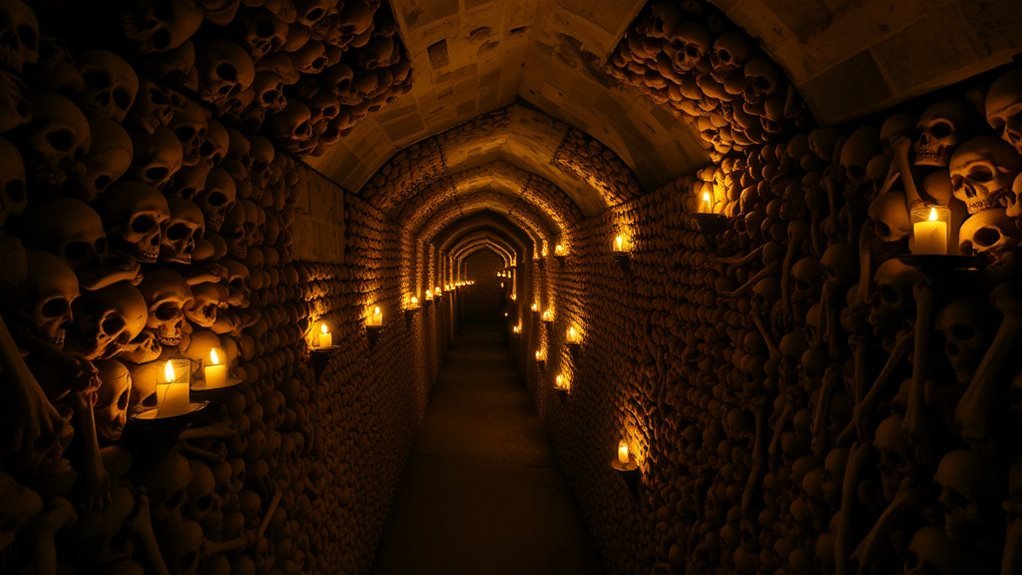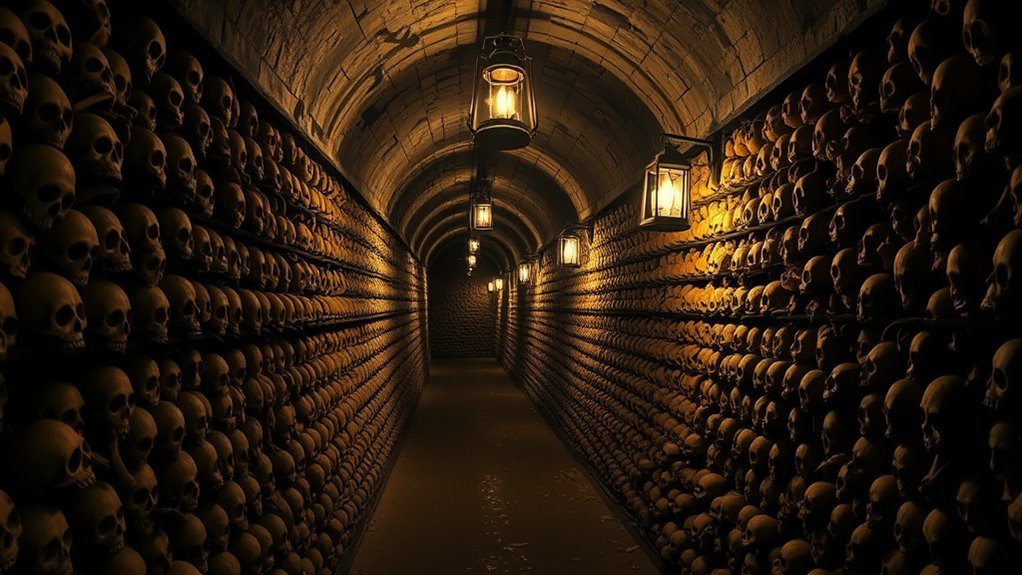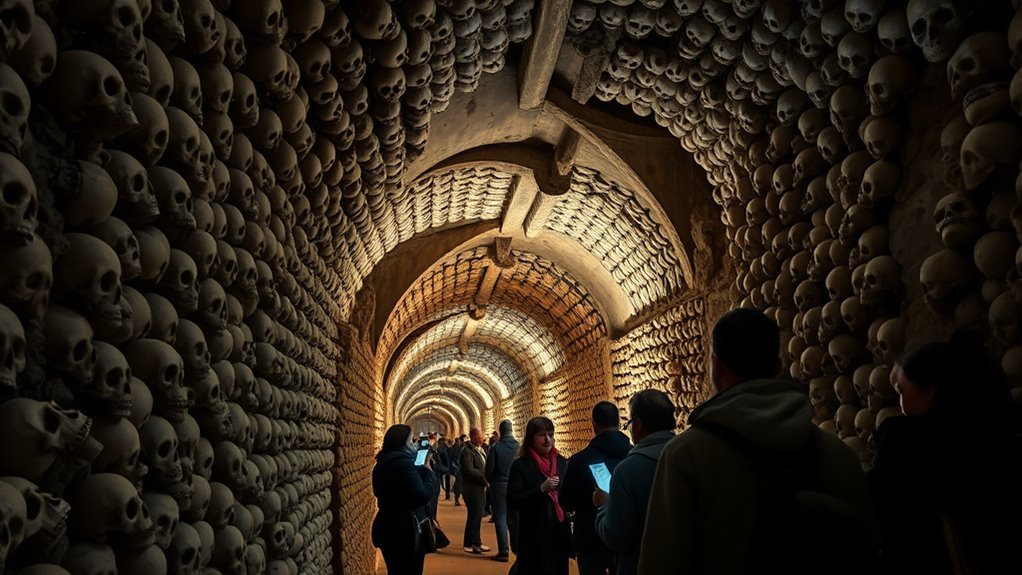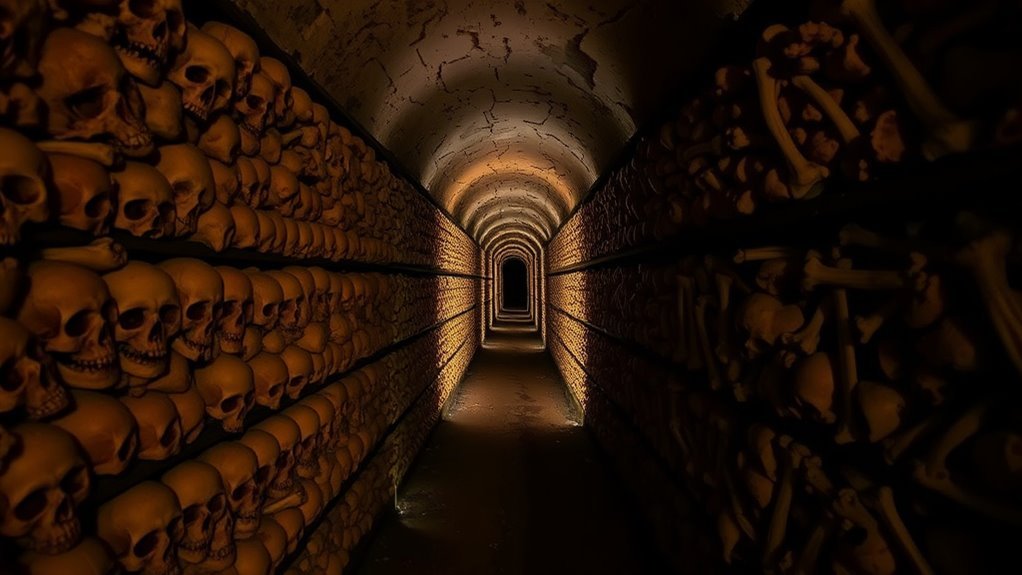Imagine standing at the entrance of a place where history and mystery intertwine beneath the bustling streets of Paris. The Paris Catacombs, a labyrinth of tunnels, hold tales of a city grappling with cemetery overcrowding and public health crises in the 18th century. As you explore further, consider how these underground ossuaries came to be and the processes that led to their creation. Curious about what lies ahead?
Key Takeaways
- The Paris Catacombs were established in the late 18th century to address overcrowding in cemeteries and public health concerns.
- Abandoned limestone quarries were repurposed as the Municipal Ossuary, with the transfer of bones commencing in 1785.
- Over six million remains were relocated to the Catacombs, primarily from the Saints-Innocents cemetery.
- The Catacombs opened to the public in 1809 and are now a popular cultural landmark with approximately 550,000 annual visitors.
- Preservation efforts involve regular inspections and collaborations with Paris Musées to enhance the visitor experience and promote historical conservation.
Origins of the Paris Catacombs

Though bustling Paris is known for its iconic landmarks, beneath its streets lies a lesser-known historical marvel—the Paris Catacombs.
In the late 18th century, Paris faced severe public health problems due to overcrowded cemeteries, particularly the Saint-Innocents cemetery. To address this, authorities decided to create the Paris Catacombs. They selected an abandoned quarry and transformed it into the Municipal Ossuary.
The first evacuations began in 1785 and continued until 1787, with bones transferred at night to avoid public outcry. This process involved moving the remains from Saints-Innocents to the catacombs.
The Municipal Ossuary was consecrated in 1786, becoming a unique solution to the city’s burial crisis. Bone transfers resumed during urban renovations in the 1840s.
The Role of Quarries in Paris
While wandering the streets of Paris, it’s easy to forget that beneath your feet lies a hidden network of quarries that have greatly shaped the city’s history.
These quarries, primarily composed of Lutetian limestone, have been mined since the Roman era, providing essential materials for construction and architecture.
However, by the late 18th century, these quarries presented public health problems due to overcrowded cemeteries. The abandoned Tombe-Issoire quarries were repurposed as a municipal ossuary, now known as the Paris Catacombs.
Unsafe mining practices led to structural instability, prompting the establishment of the Inspection Générale des Carrières in 1774 to guarantee safety.
In 1786, bones were transferred from the Saints-Innocents cemetery, marking a significant transformation in addressing urban challenges.
Health Concerns and Cemetery Overcrowding

As you explore the labyrinth beneath Paris, it’s important to understand how health concerns and cemetery overcrowding transformed these underground spaces.
In the 18th century, severe public health problems associated with overcrowded cemeteries, such as the largest cemetery in Paris, Saint Innocents, became a pressing issue. Decomposing bodies contributed to miasmas, believed to affect air quality and disease spread.
Citizens and authorities, alarmed by the proximity to decaying matter, recognized the urgent need for a solution. The situation reached a critical point in 1780 when a basement wall collapsed, heightening public fear.
This led to the decision to transfer remains to the underground quarries, resulting in the creation of the Paris Municipal Ossuary by 1786.
The Bone Transfer Process
As you explore the bone transfer process that started in 1785, imagine the nighttime scene where workers secretly moved bones from the overcrowded Saints-Innocents cemetery.
Using covered wagons, they transported the remains to the Tombe-Issoire quarries to avoid public and Church scrutiny.
Upon arrival, quarry workers played a vital role by arranging the bones in the galleries, shaping what would become the Paris Catacombs.
Nighttime Bone Relocation
Beginning in 1785, the bone transfer process was a clandestine operation conducted at night. This nighttime endeavor aimed to relocate remains from the overcrowded Saint-Innocents cemetery to the underground ossuary, now known as the Paris Catacombs. The operation was discreet to sidestep public and Church opposition.
Here’s the process:
- Evacuation Timing: Transfers happened at night to minimize attention.
- Transportation Method: Bones were loaded into covered wagons to ensure secrecy.
- Final Destination: The remains were dumped into quarry wells, eventually forming the Municipal Ossuary.
- Enduring Effort: This meticulous bone transfer continued until 1814, resuming in 1840, to accommodate ongoing urban needs.
This operation marked the transformation of the Tombe-Issoire quarries into a vast resting place for millions.
Saints-Innocents Cemetery Evacuation
While Paris faced mounting public health concerns due to the overcrowded Saint Innocents cemetery, authorities initiated a massive and secretive evacuation process in 1785.
This decision followed the cemetery’s closure in 1780 after nearly ten centuries of use, during which it had become a significant health hazard.
To address the issue, bones were discreetly transported at night to the Tombe-Issoire quarries, minimizing public and Church resistance.
The first procession occurred on April 7, 1786, setting the stage for a two-year operation.
Eventually, approximately 6 million remains were moved to the Paris catacombs.
These bones were dumped into quarry wells and distributed through underground galleries, marking a significant turning point in the city’s approach to managing its burial practices.
Quarry Workers’ Role
The secretive evacuation of the Saints-Innocents cemetery set the stage for one of the most unique operations in Paris’s history, deeply involving the city’s quarry workers. Tasked with the bone transfer process, they transported remains of over six million individuals to the underground galleries of the Catacombs. This operation was a public health measure, initiated after the cemetery’s closure in 1780.
Here’s how it unfolded:
- Covert Operations: Bones were moved at night in covered wagons to avoid public and Church opposition.
- Meticulous Handling: Quarry workers carefully dumped bones into quarry wells for distribution.
- Continuous Role: Their involvement resumed in 1840 during urban renovations.
- Legacy: Their efforts created a lasting ossuary beneath Paris, integral to its history and expansion.
Public Access and Historical Visitors
You’re about to embark on a fascinating journey through the history of public access to the Paris Catacombs, where visitors have been both intrigued and inspired since 1810.
Initially, only a select few, including figures like the Count of Artois, Francis I, and Napoleon III, could witness the eerie beauty and profound history contained within.
As curiosity grew, so did the number of visitors, leading to today’s structured experience that welcomes hundreds of thousands annually.
Notable Historical Visitors
Since its official opening to the public in 1809, the Paris Catacombs have drawn a long list of notable historical visitors, cementing its reputation as a place of intrigue and fascination.
The allure of this historical site attracted many notable figures, making it a sought-after destination for those with a penchant for history and mystery.
Here are some notable visitors:
- Count of Artois: He visited in 1787, even before public access was granted, showcasing early interest from the aristocracy.
- Francis I of Austria: His 1814 visit highlighted the appeal of the Catacombs to royalty and foreign dignitaries.
- Napoleon III: He explored the depths in 1860, reinforcing its cultural significance.
- Annual Visitors: Today, approximately 550,000 visitors continue to explore its mysteries.
Changing Visitor Arrangements
While notable figures like the Count of Artois and Napoleon III have explored the Paris Catacombs, the way people access this fascinating site has undergone considerable transformation over time.
In 1809, public access was initially by appointment, allowing visitors to explore the ossuary officially. The Catacombs were consecrated as the Paris Municipal Ossuary in 1786, marking the start of their storied history.
Over time, access arrangements evolved, reflecting growing public interest. From restricted visits to accommodating approximately 550,000 visitors annually, the Catacombs’ appeal has continued to grow.
In 2002, they partnered with the Carnavalet Museum, further enhancing their visibility and accessibility.
Today, these arrangements guarantee that you can fully appreciate the historical significance and allure of this unique site.
Public Curiosity Origins
As you explore the origins of public curiosity surrounding the Paris Catacombs, it becomes clear how this underground marvel has intrigued visitors since its consecration as the Paris Municipal Ossuary on April 7, 1786.
The catacombs, resembling ancient Roman burial sites, sparked fascination as soon as public access began in 1809 by appointment.
Housing the remains of over six million people, it quickly became a destination for historical visitors and thrill-seekers alike.
Consider these enthralling details:
- Notable Visitors included the Count of Artois in 1787, Francis I in 1814, and Napoleon III in 1860.
- Public Access: Initiated in 1809, this led to the development of organized tours.
- Annual Attendance: Approximately 550,000 visitors today.
- Enduring Fascination: A unique allure for those confronting mortality.
The Catacombs as a Cultural Landmark
Despite their somber theme, the Catacombs of Paris are a fascinating cultural landmark, drawing about 550,000 visitors each year.
As you explore the Paris Catacombs, you’ll encounter a unique blend of historical burial practices and modern curiosity. These underground tunnels, stretching over 300 kilometers (with only 1.5 kilometers open to you), offer a glimpse into Paris’s history. The entrance’s chilling inscription, “Arrête! C’est ici l’empire de la Mort,” sets the tone for a journey through memory and mortality.
The Catacombs have inspired countless artistic expressions, from Gothic fiction to contemporary films, solidifying their place as a rich cultural landmark.
A source of endless inspiration, the Catacombs fuel artistic creativity across eras, from Gothic tales to modern cinema.
Managed by Paris Musées, this tourist attraction continues to remind visitors of the city’s intricate relationship with life and death.
Modern Developments and Uses

Over the years, the Paris Catacombs have incorporated modern developments to enhance the visitor experience.
In 2002, they officially affiliated with the Carnavalet Museum, which boosted their promotion and public engagement. Significant improvements have been made to visitor amenities, ensuring greater comfort while exploring these historic passages.
Here’s what you’ll find today:
- New Entrance and Exit: Since 2019, the restored Ledoux house provides better accessibility, while an exit and bookstore-boutique opened in 2017 enhance your visit.
- Guided Tours: These tours offer deeper insights into the Catacombs’ historical significance.
- Cultural Activities: Events and educational programs bring the Catacombs’ history to life.
- Annual Visitors: With approximately 550,000 visitors a year, the Catacombs remain a significant cultural attraction.
Challenges and Preservation Efforts
Though the Paris Catacombs captivate countless visitors, they face significant challenges that require ongoing attention. Structural instability from old quarries and sinkholes demands regular inspections and maintenance by the Inspection Générale des Carrières (IGC), ensuring safe public access. Vandalism and unauthorized access have also plagued the Catacombs, resulting in increased security measures and temporary closures for repairs. Preservation efforts focus on maintaining the ossuary and tunnels while educating visitors about the site’s history.
| Challenges | Preservation Efforts |
|---|---|
| Structural Instability | Regular inspections by IGC |
| Vandalism & Access Issues | Increased security measures |
| Public Access Needs | Educational programming & maintenance |
Since 2002, the Catacombs have benefited from enhanced promotion as part of the Carnavalet Museum, balancing visitor interest with historical preservation.
FAQs
1. What Is the Story Behind the Paris Catacombs?
You’re curious about the story of the Paris Catacombs. They originated to address cemetery overcrowding, relocating bones underground. Initially secretive, these tunnels now fascinate visitors with their history, housing the remains of over six million people.
2. How Many People Died in the Paris Catacombs?
You might think people died there, but that’s not the case. The catacombs house remains transferred from other places. Around six million people’s bones rest there, relocated mainly due to overcrowded cemeteries and public health concerns.
3. Why Are There Human Remains in the Paris Catacombs?
You find human remains in the Paris Catacombs because authorities moved them there from overcrowded cemeteries. They aimed to address public health concerns and prevent the spread of disease due to decaying bodies in populated areas.
4. Why Are the Paris Catacombs so Popular?
You love exploring the Paris Catacombs for their eerie atmosphere, historical intrigue, and unique architecture. The thrill of uncovering hidden mysteries and the dramatic entrance message captivate your imagination, making it an unforgettable experience.

